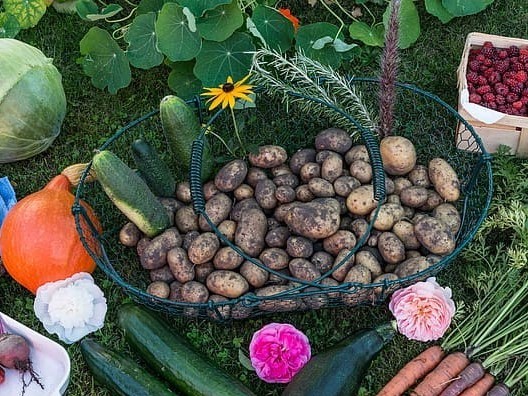
[vc_row][vc_column][vc_column_text]
Backyard Gardening
By: Riley Rossi
During this time of social distancing, many of us are spending too much time at home restless and bored. One can only watch Tiger King so many times. Why not spend our time doing something hands-on, productive, and outside? If you have space, a simple garden in your backyard can be that new hobby, and it has plenty of obvious and hidden benefits for you and the environment. This is how I got started.
The first thing I asked myself was “What do I want to grow?” Do I grow large vegetables such as potatoes, tomatoes, or beans? Or do I grow some herbs such as basil, cilantro, and mint? Or do I just want to grow some beautiful flowers “Animal Crossing” style? I tried all three, some with more success than others.[/vc_column_text][/vc_column][/vc_row][vc_row][vc_column width=”1/2″][vc_column_text]Deciding where I want and could place this small garden was important. You have to think of sunlight and wind exposure. Are my plants going to receive enough sunlight or is there a giant tree blocking my path? Is the wind going to blow it all away? Where do the gutters drain to? Know your house. The east side of my house was the best location for me when taking all of these factors into consideration.
Next, you will want to gather all of the necessary supplies. Gloves, hand trowel, watering can, pruning shears, garden forks, spade, rakes. You might not need all this for something as small as growing cilantro, but they helped. Gloves, a trowel, and a watering can helped to get me started; all three for less than ten dollars at the local dollar store.[/vc_column_text][vc_column_text]While gathering all of my supplies, I also started germinating. Who knew it was as simple as placing the seeds in between a damp paper towel and waiting? While I waited; I went and tested my soil. My local hardware store had a cheap PH meter that also measured moisture. For a simple tutorial on how to germinate, watch our video to the right.
If you want to learn more about how to test your soil, go here. [/vc_column_text][/vc_column][vc_column width=”1/2″][vc_single_image image=”11814″ img_size=”large”][vc_video link=”https://www.youtube.com/watch?v=FLSj1rjm6pc”][/vc_column][/vc_row][vc_row][vc_column][vc_column_text]
Planting and Transplanting
There are two main things to consider when planting or transplanting: timing and acclimation.
What time of year should you plant outdoors? This depends on where you live and what you are planting. You want to make sure your new seedlings or transplants do not go in the ground until the last spring frost is over. Furthermore, certain plants thrive in different temperatures and may grow better when planted at different times of the year. You can determine the most ideal time of year by either reading the information on the seed packet or utilizing a “growing guide” such as the one found here.
Did the seeds start indoor or outdoor? If the answer is indoors, then the seedlings need to become acclimated to the outside environment before transplanting. This process is called “hardening”, in which you slowly introduce the plants to their new environment, and can take 1-2 weeks. It gives the plants a chance to get acclimated to the outside before transplanting begins. To learn more about the process of hardening, go here.
When your seedlings are acclimated and ready to be planted, follow these few simple steps:
- Dig a hole large enough for the seedlings
- Carefully remove seedlings while trying not to disturb the roots
- Set seedlings level with the soil surface
- Water seedlings
- Mulch area to maintain moisture and temperature
[/vc_column_text][vc_column_text]
Benefits of Gardening
- The environment plays an important role in everyday life. One of the benefits of starting your own garden is saving money on homegrown vegetables. The trick to spending less is to maximize your garden space with high yield crops like tomatoes, beans, squash, etc.
- People who garden to grow their own food help decrease the pollution that is put into the atmosphere. You can consume the vegetables that you have grown instead of buying them at the store. This reduces the supply of vegetables that need to be transported and delivered to the markets. Gardens reduce the number of trucks on the road that ship food to the grocery stores. It saves on the fossil fuels and energy that is being used.
- As mentioned earlier it’s also a great way to stay active. There is an accumulation of studies that show gardening can be beneficial to both mental and physical health because it combines physical activity as well as exposure to nature and sunlight.
- Growing certain native plants and trees have numerous environmental benefits. Some of these benefits include providing much-needed shelter and food for wildlife (most importantly our pollinators!) and enhancing local ecosystem services by producing cleaner air, better water retention, and reducing erosion. Native plants also require less water, less pest management, and less overall maintenance; a win-win for both your wallet and the environment!
- A starter list of backyard native plants to provide food and shelter for wildlife include:
- Black-eyed Susans
- Sunflowers
- Milkweed
- Goldenrod
- Blueberries
- Buttonbush
- White oak
- Black gum
You can look up an even more detailed list of native plants, by going here.[/vc_column_text][/vc_column][/vc_row]
